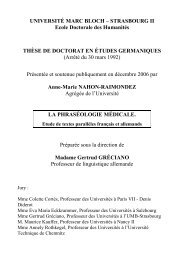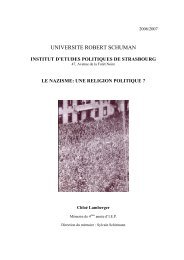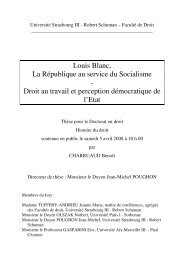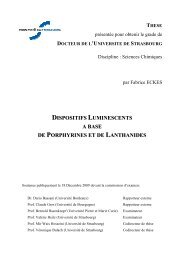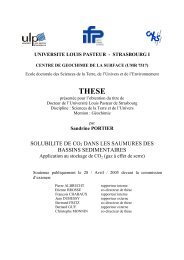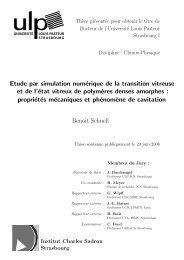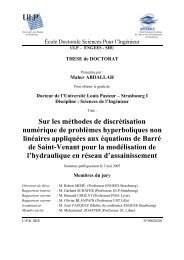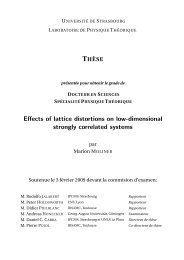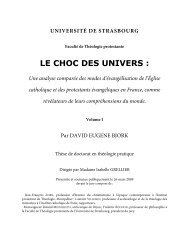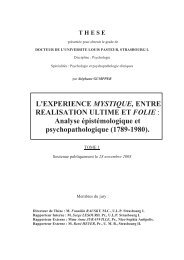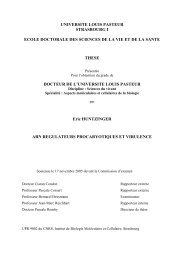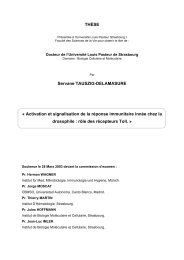Anthony KERMAGORET - THESES ET MEMOIRES DE L'UDS
Anthony KERMAGORET - THESES ET MEMOIRES DE L'UDS
Anthony KERMAGORET - THESES ET MEMOIRES DE L'UDS
Create successful ePaper yourself
Turn your PDF publications into a flip-book with our unique Google optimized e-Paper software.
Chapitre II<br />
a dark green powder. Yield: 0.97 g (72%). Anal. Calcd. for C12H13ClN2NiO2: C, 46.29; H,<br />
4.21; N, 9.00. Found: C, 45.92; H, 4.57; N, 8.64. IR (KBr): 1632 (vs), 1597 (vs), 1569 (s sh),<br />
1479 (w), 1438 (s), 1371 (vs), 1282 (m), 1244 (w), 1153 (w), 1077 (s), 1049 (s), 848 (m), 761<br />
(vs), 729 (w), 704 (m), 643 (w) cm -1 .<br />
Oligomerization of Ethylene<br />
All catalytic reactions were carried out in a magnetically stirred (900 rpm) 145 mL<br />
stainless steel autoclave. A 125 mL glass container was used to protect the inner walls of the<br />
autoclave from corrosion. The preparation of the catalytic solution of the precatalyst is<br />
depended of the nature and the amount of the cocatalyst.<br />
With AlEtCl2, 4x10 -2 mmol of Ni complex were dissolved in 14, 13 or 12 mL of<br />
cholorobenzene depending on the amount of the cocatalyst and injected into the reactor under<br />
an ethylene flux. Then 1, 2 or 3 mL of a cocatalyst solution, corresponding to 2, 4 or 6 equiv.<br />
respectively, is added to form a total volume of 15 mL with the precatalyst solution. When<br />
1.05x10 -2 mmol of precatalyst was used, a solution of the complex in 14 mL of<br />
chlorobenzene was injected into the reactor, followed by 0.26, 0.52 or 0.75 mL of a solution<br />
of the cocatalyst corresponding to 2, 4 or 6 equiv of AlEtCl2 respectively.<br />
With MAO, 1.05x10 -2 or 4x10 -2 mmol of Ni complex was dissolved in 10 mL in<br />
chlorobenzene and injected into the reactor under an ethylene flux. Then 2, 4 or 8 mL (for a<br />
complex amount of 4x10 -2 mmol) or 0.51, 1.05 or 2.10 mL (for a complex amount of<br />
1.05x10 -2 mmol) of a cocatalyst solution, corresponding to 50, 100 or 200 equiv. of MAO<br />
respectively, was added.<br />
All catalytic tests were started between 25 and 30 °C, and no cooling of the reactor<br />
was done during the reaction. After injection of the catalytic solution and of the cocatalyst<br />
under a constant low flow of ethylene, the reactor was pressurized to 10 bar. A temperature<br />
increase was observed which resulted solely from the exothermicity of the reaction. The 10<br />
bar working pressure was maintained during the experiments through a continuous feed of<br />
ethylene from a reserve bottle placed on a balance to allow continuous monitoring of the<br />
ethylene uptake. At the end of each test (35 min) a dry ice bath, and in the more exothermic<br />
cases also liquid N2, was used to rapidly cool down the reactor, thus stopping the reaction.<br />
When the inner temperature reached 0 ºC the ice bath was removed allowing the temperature<br />
to slowly rise to 10 ºC. The gaseous phase was then transferred into a 10 L polyethylene tank<br />
filled with water. An aliquot of this gaseous phase was transferred into a Schlenk flask,<br />
previously evacuated, for GC analysis. The products in the reactor were hydrolyzed in situ by<br />
22



